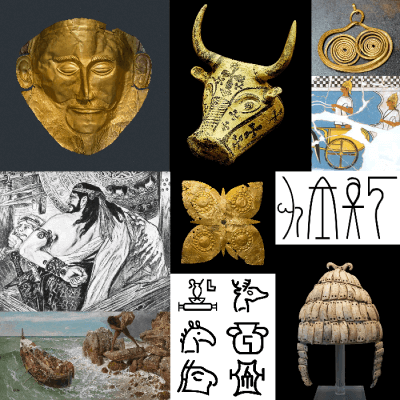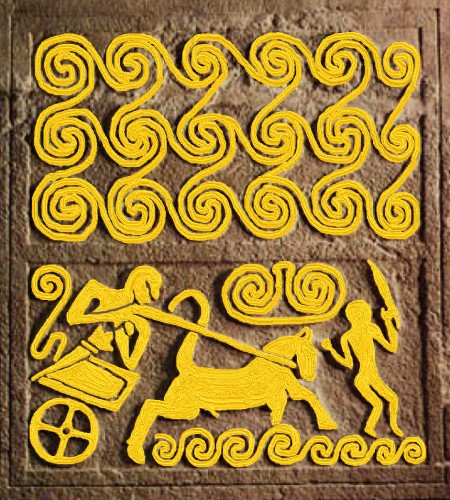Mycenaean Greece

This Indo-European culture existed from 1600 BC to 1100 BC.
Various collective terms for the inhabitants of Mycenaean Greece were used by Homer in his 8th century BC epic, the Iliad, in reference to the Trojan War. The latter was supposed to have happened in the late 13th – early 12th century BC, when a coalition of small Greek states under the king of Mycenae, besieged the walled city of Troy. Homer used the ethnonyms Achaeans, Danaans and Argives, to refer to the besiegers. These names appear to have passed down from the time they were in use to the time when Homer applied them as collective terms in his Iliad. There is an isolated reference to a-ka-wi-ja-de in the Linear B records in Knossos, Crete dated to around 1400 BC, which most probably refers to a Mycenaean (Achaean) state on the Greek mainland.
In circa 1600 BC, the Mycenaean Greeks borrowed from the Minoan civilization its syllabic writing system (Linear A) and developed their own syllabic script known as Linear B. The Linear B script was utilized by the Mycenaean palaces in Greece for administrative purposes where economic transactions were recorded on clay tablets and some pottery in the Indo-European Mycenaean dialect of the Greek language. The Linear B tablets were first discovered in Crete by English archaeologist Sir Arthur Evans around the year 1900 and later deciphered by an English architect and cryptographer Michael Ventris in 1952.
In the official records of another Bronze Age empire, that of the Hittites in Anatolia, various references from around 1400 BC to 1220 BC mention a country named Ahhiyawa. Another similar ethnonym Ekwesh in twelfth century BC Egyptian inscriptions, has been commonly identified with the Ahhiyawans. These Ekwesh were mentioned as a group of the Sea People.
💀 Among the various burial types, the shaft grave became the most common form of elite burial, a feature that gave the name to the early period of Mycenaean Greece. Among the Mycenaean elite, deceased men were usually laid to rest in gold masks and funerary armor, and women in gold crowns and clothes gleaming with gold ornaments. At the end of the Shaft Grave era, a new and more imposing type of elite burial emerged, the tholos: large circular burial chambers with high vaulted roofs and a straight entry passage lined with stone. 💀

The military nature of the Mycenaean Greeks is evident from the numerous weapons unearthed, the use of warrior and combat representations in contemporary art, and the preserved Greek Linear B records. The Mycenaeans invested in the development of military infrastructure, with military production and logistics being supervised directly from the palatial centers. According to the Linear B records in the palace of Pylos, every rural community (the damos) was obliged to supply a certain number of men who had to serve in the army. Similar service was also performed by the aristocracy.

Mycenaean armies were initially based on heavy infantry, equipped with spears, large shields and in some occasion armor. Later in the 13th century BC, Mycenaean warfare underwent major changes both in tactics and weaponry and armed units became more uniform and flexible, while weapons became smaller and lighter. The spear remained the main weapon among Mycenaean warriors, while the sword played a secondary role in combat. Other offensive weapons used were bows, maces, axes, slings and javelins.The precise role and contribution of chariots on the battlefield is a matter of dispute due to the lack of sufficient evidence. It appears that chariots were initially used as fighting vehicles during the 16th to 14th centuries BC, while later, in the 13th century BC, their role was limited to battlefield transport.
The boar's tusk helmet was the most identifiable piece of Mycenaean armor in use from the beginning to the collapse of Mycenaean culture. It is also known from several depictions in contemporary art in Greece and the Mediterranean. A representative piece of Mycenaean armor is the Dendra panoply (1450 BC – 1400 BC) which consisted of a cuirass of a complete set of armor made up of several elements of bronze. In general, most features of the later hoplite panoply of classical Greek antiquity, were already known to Mycenaean Greece. The so called "figure-of-eight" shields were the most common type of Mycenaean shields. During the Late Mycenaean period, smaller types of shields were adopted, either of completely circular shape, or almost circular with a part cut out from their lower edge.
Religion
The offerings to the Gods were made from goat and cattle. A black sheep was offered to the Earth and the white one to the Sun. Hecatomb was a sacrifice to the Gods made of 100 cows. It was mainly offered to Hera, Athena and Apollo, during special religious ceremonies. At the end of the Olympic Games, a hecatomb was also offered to Zeus at Olympia.
There was an active interpreter of dreams among the Mycenaeans and the dreams were considered to be sent by the Gods. The Gods themselves were thought to reside in heavens.
The first rays of the morning Sun were considered to be the pink fingers of the Dawn Goddess Eos.
Kronion (the son of Cronos = Zeus) was said to once battle a dragon and his scared number was 9.
Iris (a rainbow) created the connection between the realm of the Gods and the Earth. It is just like in the Nordic religion with Bifrost - a burning rainbow bridge that reaches between Midgard (Earth) and Asgard, the realm of the Gods.
The Gods did not have blood, they did not eat bread and did not drink wine. In Odyssey it is also said that they gather in a circle and the fate of the mortals is decided through a debate between them. A smilar practice existend among the Slavic people by the veche (wiec, věšte). In the 6th century Procopius of Caesarea wrote: "For these nations, the Sclaveni and the Antae, are not ruled by one man, but they have lived from of old under a democracy, and consequently everything which involves their welfare, whether for good or ill, is referred to the people.", the veche was broadly similar to the Norse thing or the Swiss Landsgemeinde, which would suggest that it could originate already in the Corded Ware Culture or even Yamna nomads gathered in a circle to discuss and decide on the matters of their tribe.
DNA
At the moment there is only one known Y-DNA haplogroup of Mycenaeans and that is J2a1 (from Galatas Apatheia, 1700 BC - 1200 BC), which shows continuity of haplogroups from Minoan samples. Minoans and Mycenaeans were genetically similar, having at least three-quarters of their ancestry from the first Neolithic farmers of Western Anatolia and the Aegean and most of the remainder from ancient populations related to those of the Caucasus and Iran.
However the Mycenaeans did have an important difference: They had some 4% to 16% DNA from Northern ancestors who came from Eastern Europe or Siberia. This suggests that a second wave of people from the Eurasian steppe came to mainland Greece by way of Eastern Europe or Armenia but didn’t reach Crete, says Iosif Lazaridis, a population geneticist at Harvard University.
Not surprisingly, the Minoans and Mycenaeans looked alike, both carrying genes for brown hair and brown eyes. Artists in both cultures painted dark-haired, dark-eyed people on frescoes and pottery who resemble each other, although the two cultures spoke and wrote different languages. The Mycenaeans were more militaristic, with art replete with spears and images of war, whereas Minoan art showed few signs of warfare.
R1b among modern Greeks ranges between 19% to 23% while R1a is between 15% to 22%.
Most of the R1b found in Greece today is of the Balkanic Z2103 variety, which would corelate with an invasion dervied straight from the Yamna Culture like in the case of Albanian DNA. There is also a minority of Proto-Celtic S116/P312 and of Italic/Alpine Celtic R1b S28/U152. R1b-Z2103 could have descended from Albania or Macedonia during the Dorian invasion, thought to have happened in the 12th century BC. Their language appear to have been close enough to Mycenaean Greek to be mutually intelligible and easy for locals to adopt.
The Mycenaeans might have brought some R1b (probably also R1b-Z2103) to Greece, but their origins can be traced back through archaeology to the Catacomb Culture from 2800 BC - 1900 BC. It was a post-Yamna culture in Ukraine, closely related to the Corded Ware Culture. It originated in the forests of central and Northern European Russia, then expanded Southward and eventually replaced the Yamna Culture. In the Catacomb Culture a new funeral practice emerged with the modelling of a clay mask over the face of the deceased. These masks may have been the prototypes of the Mycenaean funerary gold masks. There is also the connection of the Mycenaeans to the Seima-Turbino phenomenon of the Northern forest-steppe, which in both cases would make them primarily an R1a tribe.
Greece lacks the R1a-Z93 component so the ancestors of Mycenaeans did not come from the area of Carpathians or Fatyanovo-Balanovo Culture. The same goes for the lack of Baltic R1a-Z92 in Greece. The area of Greece in the West and Albanian South is mostly dominated by the R1a subclade R1a1a1b1a2b3, which comes from the R1a-Z280 nowadays common mostly in Central Europe Poland near the Carpathian Mountains, in Moldova, Romania and Hungary. The North of Greece and Greek Macedonia is dominated by the subclade R1a1a1b1a1b, from R1a-M458 that is nowadays mostly found in Bulgaria, Slavic Macedonia, Wallachia (all from the R1a-Z2953 of M458) and in Poland, Czech Republic, Slovakia.
A study from 2021 finds that early Minoan, Cycladic and Helladic civilizations were genetically homogeneous and not the product of migrations from the East. By the Middle Bronze Age (2000 BC - 1400 BC) individuals from the Northern Aegean (Greece) were considerably different compared to those in the Early Bronze Age. These individuals shared half their ancestry with people from the Pontic-Caspian steppe, a large geographic region stretching between the Danube and the Ural rivers and north of the Black Sea. It means that over the Bronze Age Indo-European DNA entered Greece with some early Greeks being almost half Yamna related.

Mycenaeans (Achaeans) used Indo-European words such as:
wide, matere, pate, tukate, kunaja, dru-tomoi, kuon, udo, reuka, Diwe, Diwo, atopoko, damo
Most of those words are very often in one group with words from Sanskrit and Avestan but also Balto-Slavic languages. This fact could suggest that indeed Achaeans came from Eastern Europe or Siberia as genetic results have shown. As the users of the spoked wheel chariots they could be influenced by the Sintashta Culture, Andronovo Culture or even late Corded Ware Culture.
In Mycenaean Greek "potinija" means "mistress" and "lady", a Lithuanian word "pats" means "mister" and "husband", in Old Church Slavonic there is a word "господь (gospodĭ)" meaning "master" and "lord", finally in oldest Sanskrit and Avestan a word "patni" has a simple meaning of "wife" (it could also be connected to Polish "pani" and "pan"). Many male names from the times of Iliad end with a typical Lithuanian "-as" or "-is" manner: Kalchas, Ajas, Hermejas, Pallas, Aineias, Akamas (the leader of Thracians) and female names: Chrisothemis, Briseis.
Article created on the 7th of February 2019.
